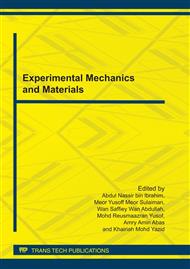[1]
Bradley D. and Creagh D. Physical Techniques in the Study of Art, Archaeology and Cultural Heritage", Vol. 1 and 2 Elsevier Publication, (2006).
Google Scholar
[2]
Casali F. X-ray Digital Radiography and Computed Tomography for Cultural Heritage, Archeometriai Muhely, pp.24-28., (2006).
Google Scholar
[3]
Lehmanna E. H., Vontobela P., Deschler-Erbb E. and Soares M., Non-invasive studies of objects from cultural heritage, Nuclear Instruments and Methods in Physics Research A 542 p.68–75, (2005).
DOI: 10.1016/j.nima.2005.01.013
Google Scholar
[4]
P. Willems, et al, Application of CR for corrosion and wall thickness Measurements, Proc. of the 7th European Conference on NDT, Copenhagen, Denmark, pp.2774-2781, (1998).
Google Scholar
[5]
Rheinlander J. and Christiansen H., Using film density variations for determination of pipe thickness variation in gamma-ray radiography, Insight, Vol. 37(9), pp.691-694., (1995).
Google Scholar
[6]
Kajiwara G., Examination of the X-ray piping diagnostic system using EGS4 (examination of the film and iron rust), Proceedings of the Second International Workshop on EGS, Tsukuba, Japan, pp.199-208, Aug. (2000).
Google Scholar
[7]
Edalati, K., Rastkhah, N., Kermani, A., Seiedi M and Movafeghi, A., The use of radiography for thickness measurement and corrosion monitoring in pipes, International Journal of Pressure Vessels and Piping, Elsevier Pub., pp.736-741, Vol. 83., (2006).
DOI: 10.1016/j.ijpvp.2006.07.010
Google Scholar
[8]
Movafeghi A., Kargarnovin M. H., Soltanian-Zadeh H., et al, Flaw Detection Improvement of Digitized Radiographs by Morphological Transformations, Insight - Non-Destructive Testing and Condition Monitoring, Vol. 47, No. 10, pp.625-630, (2005).
DOI: 10.1784/insi.2005.47.10.625
Google Scholar
[9]
Lee S. S. , Thickness evaluation of pipes using density profile on radiographs, in 10th Asia-Pacific Conference on Non-Destructive Testing, Brisbane, Australia, 17-21, (2001).
Google Scholar
[10]
Zscherpel U., Film digitization systems for DIR: Standards, Requirements, Archiving and Printing, NDT. net, vol. 5, No. 5., (2003).
Google Scholar
[11]
Movafeghi A., Krgarnovin M. H., Soltanian-Zadeh H. et al, , A radiographic calibration method for eddy current testing of heat exchanger tubes", Insight - Non-Destructive Testing and Condition Monitoring, Vol. 46, No. 10, pp.594-597. (2004).
DOI: 10.1784/insi.46.10.594.45211
Google Scholar
[12]
Gonzales R. C., and Woods R. E., Digital Image Processing, 3rd edition, Prentice Hall Inc. (2009).
Google Scholar
[13]
MATLAB Help for image processing toolbox, Mathworks Inc., (2007).
Google Scholar
[14]
Edalati K., Rastkhah N., Kermani A., Seiedi M and Movafeghi A., In-service corrosion evaluation in pipelines using gamma radiography - a numerical approach, Insight the Journal of The British Institute of Non-Destructive Testing, Vol. 46, No. 7, pp.396-398. (2004).
DOI: 10.1784/insi.46.7.396.55583
Google Scholar
[15]
Wainwright, I. N.M., Examination of Paintings by Physical and Chemical Methods, Department of Communications, and held at the National Gallery, Canadian Conservation Institute (CCI) – Publications , http: /www. cci-icc. gc. ca/ accessed Oct. (2007).
Google Scholar
[16]
Ghose B., Kankane D.K. , Estimation of location of defects in propellant grain by X-ray radiography, NDT&E International Vol. 41 pp.125-128, (2008).
DOI: 10.1016/j.ndteint.2007.08.005
Google Scholar
[17]
Giannoulaki M., Argyropoulos V., Panou Th., Moundrea-Agrafioti A. and Themelis P., The feasibility of using portable X-Ray radiography for the examination of the technology and the condition of a metals collection housed in the Museum of Ancient Messene, Greece, e-Journal of Science & Technology(e-JST), pp.48-63, (2006).
Google Scholar
[18]
Stuart B. H., Analytical Techniques in Materials Conservation, John Wiley & Sons Ltd., (2007).
Google Scholar


